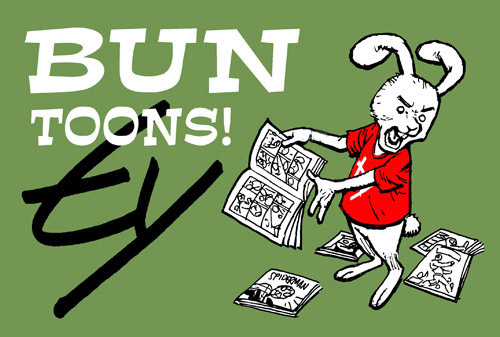
Literally.
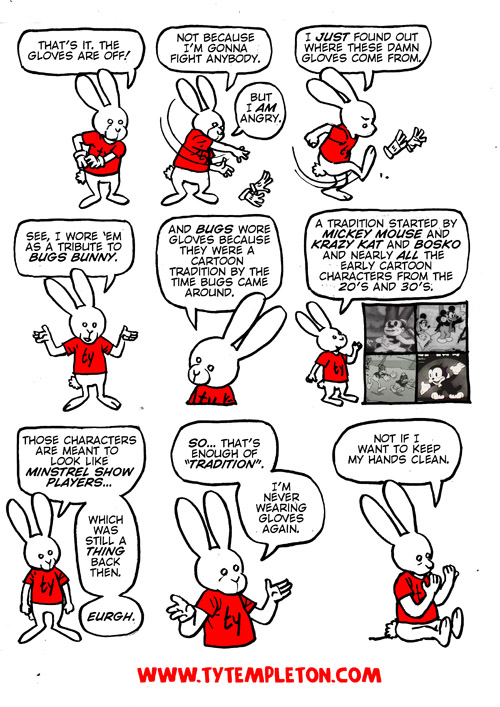
Tradition is a weak reason to continue things that are echoes of a truly awful past.
Ty the Guy OUT!
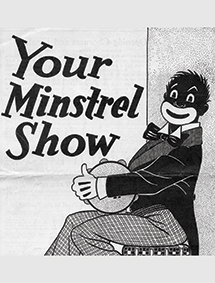
When you compare the outfit that minstrel show player above is wearing and the shapes of light/dark in the face above….to THIS common image of Mickey Mouse below…
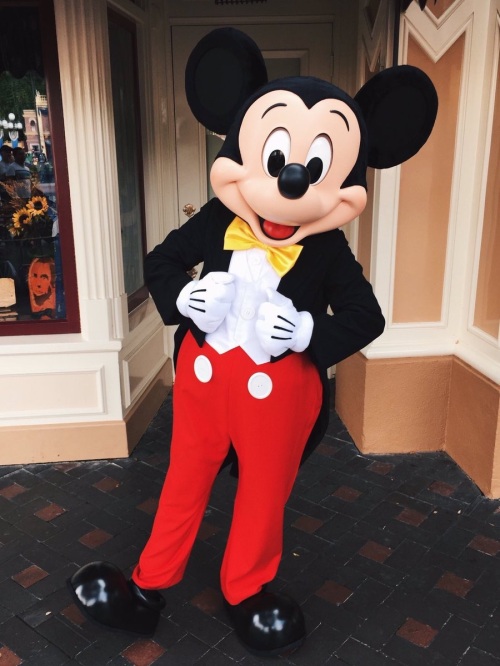
….a beloved children’s character suddenly becomes part of a ghastly, terrifying “tradition” that starts bringing up the lunch.
I only really began to look into this recently, after hearing a tossed off joke about it on the Samantha Bee show this week.
Disney has known about this for every minute of the last ninety years and they’re fine with it. No big redesign since the early Minstrel Show roots:
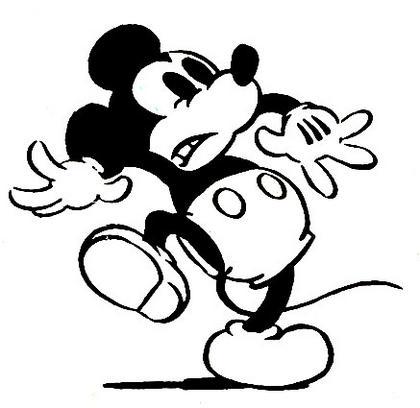
Hmm…
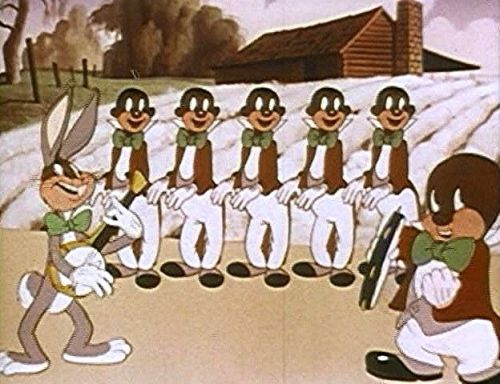
Bugs Bunny is certainly aware of his roots as well. There’s PLENTY of disgusting stuff in the Warner Brothers/ Bugs Bunny library that never played on your TV when you were a kid, because of how awful it was.
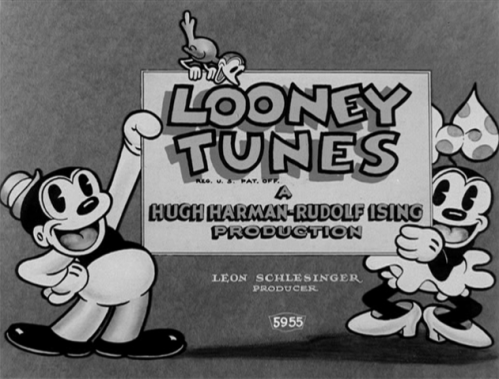
THE CHARACTER ON THE LEFT IS LITERALLY NAMED “BOSKO THE NEGRO BOY”.
These images are quite tame compared to what’s out there.
“It was a different time.” That’s usually how the tradition is excused.
So let’s leave the tradition to another time.
The past.
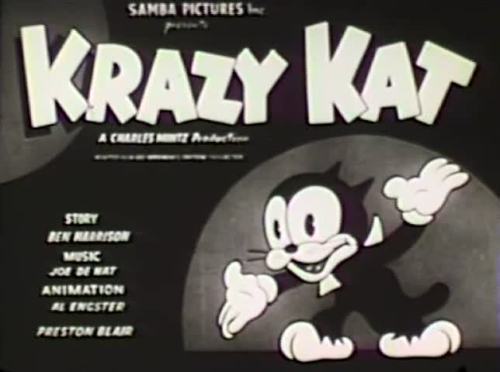
Krazy Kat was created by George Herriman…who was black, by the way.
Make sense out of that.

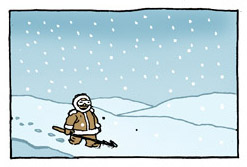


Obviously, the idea did not bother Harriman, probably because gentlemen were expected to wear gloves until fairly recently, and there are still circumstances where gloves may be expected.
I think it’s also worth noting that Mickey did not wear gloves in his first appearance. Wikipedia says he got them with his fifth, The Opry House.
Still, no reason for for the Bun to keep his.
Just found Walt Disney’s explanation for the gloves: ‘We didn’t want him to have mouse hands, because he was supposed to be more human. So we gave him gloves. Five Fingers looked like too much on such a little figure, so we took one away. That was just one less finger to animate.’
One more point: the first cartoons were in black and white. Mickey’s hands were more visible when he started wearing gloves. Once they’d established that, they kept it when they went to color.
Yes, Will….I’ve read the revisionist nonsense that Walt Dizzy tried to spin about the contrast and the three fingers. None of which explains the facial patterns and the spats and tails. There’s no walking it back….Mickey is dressed as a minstrel show character…especially the theme park costume. It’s not like Walt Dizzy, a famous anti-Semite, was ever accused of being a liberal.
Sure, and Disney also didn’t like hiring women. But that doesn’t mean Mickey Mouse is intended to mock black people. And frankly, if he is a mockery of black people, adopting gloves a few cartoons after his first appearance isn’t the problem.
No, I don’t think Mickey Mouse is intended to mock black people, TODAY But there was no question that animation studios were happy to mock black people in the 20s and 30s, there’s so many examples of it, it’s silly to argue it. Mickey today is better, yes…but still echoing the less obvious elements of blackface/minstrel design work, despite a strong redesign in the 50s-
So Disney was conscious of it at least. But he didn’t remove everything that was problematic.
The Spirit’s EBONY WHITE and the Lone Ranger’s TONTO have equally problematic original designs that get tweaked away in modern versions.
I’m not arguing that there weren’t racist works, and I’m very aware Disney made the remarkably clueless Song of the South. The question is whether Mickey, from his first appearance, was intended to be seen as a black character. If so, he was a scrappy and inventive black hero who did not talk like a black character.
Out of curiosity, how do you think he should be revised? Besides never wearing gloves or spats? Should they change his color, like the Hulk going from grey to green?
are you sure this is not just a ‘mr. peanut’ old-fashioned gentleman clothes? is mr peanut racist too?
The movie Krazy Kat looks different from the comic strips. Here, he looks more like Felix. Another interesting thing in the strips, Herriman can’t seem to make up his mind whether Krazy Kat was male or female or he couldn’t care less, which is interesting since Krazy Kat is romantically obsessed with Ignatz the mouse. Herriman was light enough to be “passing” and that is controversial nowadays. He knew he was able to get more jobs by passing and probably how he got his cartoons in newspapers.
I was wondering that too – that Krazy Kat doesn’t look even remotely like the art from the strips. Is it possible that it’s some other thing with the same name?
And nothing I can find on Wikipedia shows art like that for the Herriman’s animated work: https://en.wikipedia.org/wiki/Krazy_Kat_filmography
No, that’s true….the early ones hewed much closer to the original Herriman look of the character. As the series went on, he started looking more and more like the standardised cartoon template. (and in fact, became a “he” –since early Krazy Kat was somewhat fluid about gender, and more often than not was female). My comment about Herriman being black and the character morphing into the minstrel show look, was about the later Krazy Kat toons. Original Krazy Kat films are from like 1916 or something. The still I chose is from a 30s film.
Did the animated Krazy Kat get his gloves after Mickey did? If so, I’d suspect the Krazy Kat cartoonists were either imitating the more successful property or swiping the Disney solution for making an inked character’s hands more distinct in a black and white medium.
Ty, you got me curious about spats. I haven’t found when Mickey started wearing them—he didn’t start with them—but this was written a year before Mickey’s spats:
Have you seen the well-to-do, up and down Park Avenue
On that famous thoroughfare, with their noses in the air
High hats and Arrow collars, white spats and lots of dollars
Spending every dime, for a wonderful time
Is this a joke? It could certainly pass as a parody of a certain mentality.
As could this comment. Walking a mile in other’s shoes, no?
Of course, you are rubber and I am glue so neener neener on me. I simply think you’re mistaken. To paraphrase Dr. Strangelove, the purpose of a demeaning racial stereotype is defeated if nobody knows about it. There was enough genuine racism in cartoons that you don’t have to make up nonsense about gloves. I believe I can categorically state that practically no one has ever taken Mickey Mouse to be a blackface minstrel figure unless they were trying to make a tendentious point. (I also doubt that anyone ever noticed that your rabbit figure wore gloves; I certainly never did.) Bugs Bunny wasn’t a minstrel figure, he was Br’er Rabbit. Or rather, he evolved into Br’er Rabbit under the influence of Chuck Jones. He was also the star of what was probably the most purely racially demeaning Looney Tunes, “All This Carrot Stew,” which was so toxic that it was withdrawn from circulation in the 40s and remade with Elmer Fudd in the stooge role. But I mean, gloves, I’ll give you credit, if you can feel a pea under that many mattresses you must be a genuine princess. Nevertheless, if there were only one seat left on the cultural lifeboat and it was between you and say Bob Clampett, if I’m making the choice you’re going to be swimming.
So, to recap. I’m a sensitive princess and you’re willing to throw me out of a lifeboat. Give me a moment, I may have the vapours.
This has inspired me to commit bloggery: http://shetterly.blogspot.com/2018/02/are-mickey-mouses-spats-and-gloves.html
No need to click through. It’s basically the argument I’ve made here, with two additional points:
4. In early cartoons, black characters spoke in an extreme southern black dialect. Mickey Mouse did not.
5. Mickey, from his first appearance, was remarkably scrappy and clever. If he was intended to be black, he should be seen as more admirable, not less.
Well, your blog post leaves out that Disney said Steamboat Willie was inspired by “The Jazz Singer” (a blackface musical of the previous year). You left out the idea of the plucky, happy-go-lucky dancing, musically inclined worker being a stock character in minstrel shows, often called “jumpin’ Jim Crow” or an “endman”.. You left out the idea of Mickey being based on Felix the Cat’s facial design, which was based on blackface characters (Felix is a banjo playing good for nothing in his original cartoons in 1921, and who is a black cat because he’s made of ink. This was part of Felix’s “origin”). You left out Disney’s first cartoon (Alice’s Wonderland) in which Alice dreams of a land filled with anthropomorphic animals who are white except for the jazz musicians (and Mickey’s designs hew far closer to the black musicians in this cartoon than to ANY of the white animals). You left out the exaggerated “bigfoot” comedy of the vaudeville blackface shows…..a tradition that that survives today with circus clowns and their big feet. (Notice how BIG Mickey’s feet are….for a MOUSE?!?) You left out the history of Bosko the Negro Boy, Warner Brother’s first continuing character, who is utterly a minstrel character and who looks quite a bit like Mickey Mouse, especially the patterns of black on his face…. There’s plenty more, but I just wanted to point out there’s so much evidence you chose NOT to include that your blog post seems more like an opinion piece and not one particularly interested in research. I spent two days looking into this stuff, watching old cartoons, looking into the history of minstrel shows, where they played, when they morphed into Vaudeville, who were the stock characters, what were the scenarios and messages, etc….I looked into the careers of Disney, Iwerks, Blair, Harmon and Ising and their history with race, before I came to my conclusions. You seem very focused on spats, when my cartoon was entirely about minstrel gloves. I’m not sure what points you scored.
Steamboat Willie inspired Disney to make a talkie. Mickey was created before Steamboat Willie. How do you think Mickey is like Jolson’s character?
I assumed everyone knew Disney had made cartoons with racial clichés, so I didn’t go into that. Do you agree that Mickey does not talk like a comic relief black cartoon character of the time?
Mickey’s hands and feet started small. He got large shoes and gloves so audiences could see what he was doing more easily in black and white cartoons.
I only mentioned spats because you brought them up in the comments.
In the course of your research, did you find any black or white writers of the time who thought Mickey was meant to mock black people? It’s very easy to find contemporary criticism of Song of the South, so I’d expect that to be true of Mickey too, if he was seen that way.
You missed the early boyfriend of Betty Boop ( name escapes me now) who look closely like Bosco. There was also a fox cartoon that looked like Bosco. There was also Oswald the Rabbit, which Disney dropped in favor of Mickey. There was a movie about origin of Mickey. I think it was called Disney before Mickey or something like that.
I don’t know how well this is researched, but the claim is interesting:
“So strong was the audience demand for Steamboat Willie that two weeks after its premiere Disney re-released it at the largest theater in the world, the Roxy in New York City. Critics came to see in Mickey Mouse a blend of Charlie Chaplin in his championing of the underdog, Douglas Fairbanks in his rascally adventurous spirit, and Fred Astaire in his grace and freedom from gravity’s laws.”
https://www.moma.org/collection/works/89284
So we know Walt Disney was racist, we know he made racist cartoons, we know he made racist comics featuring Mickey Mouse but you would like to argue (and argue and argue) that the white gloves have utterly nothing to do with minstrel show characters (who wore gloves, tails and spats) because… Because why exactly?
How nice that people could find pretty words to dress up the character and make it palatable to a white audience. When Al Jolson was in blackface no one in the audience was laughing and saying, “Get it? It’s funny because he’s pretending to be a black man! Hahaha!” They just accepted it as a normal thing to do; because black people were not seen as equivalent to white people at all. People would acknowledge that black people could sing really well, and could play instruments at the very same time that they thought they were stupid and lazy.
At some point, if you’re willing to acknowledge Disney’s racism and the products he made that demonstrated that racism, this seems an odd sticking point: that there’s no way that the gloves had anything to do with a black characterization.
So is the argument that Mickey is black when he wears gloves and white when he takes them off?
And if he’s supposed to be black, why didn’t he speak with the same dialect that comic black characters use in other early cartoons?
Two notes: “Steamboat Willie” was inspired by Buster Keaton’s “Steamboat Bill, Jr.” which came out that year. It was inspired by “Jazz Singer” insofar as syncing sound.
And in “Steamboat Willie”, Mickey doesn’t have white gloves, he goes barehanded. Nor does Mickey have them in his two earlier appearances in “Plane Crazy” and “The Gallopin’ Gaucho”. Mickey doesn’t start wearing gloves until his 4th film, “The Barn Dance”. See https://en.wikipedia.org/wiki/Steamboat_Willie#/media/File:Earlypete.jpg
My guess, looking at the earlier cartoons, is that the black hands came across as blobs on the screen and needed definition.
Yup, inspired by Steamboat Bill (the Keaton film, I own a copy btw) and Jazz Singer (synced sound), AND Felix the Cat (basic design was ripped off from the uber-successful character that pre-dates Mickey by about five years). The two “earlier” Mickey appearances (Gallopin’ Gaucho and Plane Crazy) were, in fact, later appearances, though the productions were begun earlier than Steamboat Willie, both other films were un-released until after the success of Willie, with fresh, synced up soundtracks. Steamboat Willie was still the first Mickey shown to the public, no matter the order they were written. And yes, he doesn’t have gloves in the first three, but neither did Bosko the Negro Boy. They still come from the tradition.
art spiegelman on the early inspirations for Maus:
http://www.nybooks.com/daily/2011/10/20/why-mice/
(It’s relevant, I swear!)
I knew I always hated Disney for a reason. Actually, there are many reasons, and I’ve known them for years, but I have to admit, I never realized this connection. But you’re absolutely right, Ty, once you see the “live” Mickey in this context, it’s IMPOSSIBLE to see him any other way.
Another stellar strip. Ghad, how I wish you would collect all of these under olde-timey paper covers someday…
Pingback: The Leporidae and the Felidae: A Love Story Bun Toon! Yay! | Ty Templeton's ART LAND!!
I used white gloves similarly in a project of mine, and this comic has made me wonder if I should retroactively take them out altogether.
I’m actually quite surprised that some people here can’t seem to understand why you’d feel uncomfortable depicting clothing that has obvious connections with something so hateful. I also find it weird that they’re disputing the idea that a piece of media from the 1920s just might contain some racist content, especially with Disney’s long history of offensive caricatures. Mickey is definitely more subtle than other examples, but that should in no way be used to excuse the intentions that went behind the design, if anything it means they should be brought up more.
If the only people in that decade who wore gloves or spats had been minstrel performers, I would agree with the people who think gloves on cartoon characters are racist.
If Mickey had worn gloves in his first appearance, I might also agree. But the history of the character’s design makes it clear that the intention was to make his hands more visible in monochrome cartoons.
Of course, that doesn’t mean anyone has to put gloves on their characters. But when you speak of other people’s motives, it is kind to give them the benefit of the doubt.
As Freud noted, sometimes a glove is only a glove.
Pingback: Ty Templeton’s playful Batman | Gotham Calling